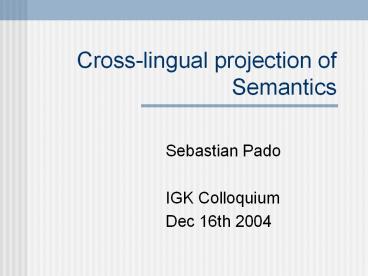Cross-lingual projection of Semantics - PowerPoint PPT Presentation
Title:
Cross-lingual projection of Semantics
Description:
Cross-lingual projection of Semantics Sebastian Pado IGK Colloquium Dec 16th 2004 Overview Background: Role Semantics Semantic Projection Current and Future Work ... – PowerPoint PPT presentation
Number of Views:72
Avg rating:3.0/5.0
Title: Cross-lingual projection of Semantics
1
Cross-lingual projection of Semantics
- Sebastian Pado
- IGK Colloquium
- Dec 16th 2004
2
Overview
- Background Role Semantics
- Semantic Projection
- Current and Future Work
3
Framework Role semantics
- Predicate-argument structure,
- Theta roles, who did what to whom
Agent
Recipient
Theme
Peter gives Mary a book
NB. No treatment of discourse relations,
modality, negation, etc.
4
Flavours of role semantics
- Top-down approach common, intuitively defined
roleset for all verbs - give is Mary Recipient or Goal or Patient?
- resemble Subj vs. Obj
- Bottom-up approach Frame Semantics
- Frames Conceptual rep of a situation Statement,
Giving, Transaction - Each frame is introduced by a target say, give,
buy - Roles are frame-specific
5
Frame Semantics
- An Example Frame Giving
- Targets give, hand out, receive
- Roles Donor, Recipient, Theme
- The Berkeley FrameNet Project
- English Frame Lexicon
- 200 Frames, 2.500 words (V/N/Adj)
- Typically 3-6 roles per frame
- Corpus of 60.000 annotated instances
6
Frame Semantics An Example
7
What do Role Semantics buy us?
- Surface-independent representation
- Solves the paraphrase problem
- Peter gives the book to Mary
- Mary receives the book from Peter
- Flexible basis for QA, Inference etc.
- Aljoscha Burchardts PhD
- Common cross-lingual semantic rep
8
Semantic Role Assignment
- Task Automatic tagging of roles on free text
- Important for NLP applications
- Linking (syntax-semantics interface)
- Statistical modelling (as classification)
- Frame semantically coherent targets
- Targets show linking idiosyncrasies
- Give Sub - Donor, Dobj - Theme, To-PP/Iobj - Rec
- Get Sub - Rec, Dobj - Theme, From-PP - Donor
- Needs lots of training data
9
Moving to another language
- SALSA Manual creation and use of a German corpus
with semantic annotation - Basis TIGER newspaper corpus, 1.5m words
- English frames (mostly) work for German
- Frame concept language-independent
- But Annotation slow and error-prone
- Total effort gt 10 person years
- Can we use the English data for German?
10
Overview
- Background Role Semantics
- Semantic Projection
- Current and Future Work
11
Central idea Semantic Projection
- Find a large, parallel bilingual corpus
- E/G part of EUROPARL (25m words)
- Assign semantic roles on English side
- Train automatic tagger on English data
- Project semantics over to German
- Step 1 Find semantic equivalences via word
alignment - Step 2 Project frame
- Step 3 Project roles
- Result Large German annotated corpus
12
Projection Example
Arriving
Arriving
Peter comes home
Peter kommt nach Hause
- Three assumptions to make this work
13
Assumption 1
- Semantic representation is parallel
Arriving
Arriving
Peter comes home
Peter kommt nach Hause
14
Semantic (im-)parallelism
- Frame definition based on realisable roles
- German and English typologically similar
- Mostly, same frames evoked
- Aspect is problematic
- Proper differences
- We finish by 12 oclock Activity_finish
- Wir sind um 12 Uhr fertig Activity_done_state
- Same aspect, lexicalised differently
- I finish by saying
- Abschliessend sage ich
15
Assumption 2
- There is always parallel lexical material that is
semantically equivalent
Arriving
Arriving
Peter comes home
Peter kommt nach Hause
16
(Im)parallelism of lexical material
- We only need semantic parallelism, only for
targets and roles - Dont care about discourse, modality, etc.
- Dont care about exact wording
- Insights from translation science
- Translation Recreation of text based on content
and target language norms - Frame structures propositional content
- Specific register
- Specific domain (no cultural differences)
17
Assumption 3
- Word Alignment provides semantic equivalence
Arriving
Arriving
Peter comes home
Peter kommt nach Hause
18
Word Alignment as Semantic Equivalence
- Current Word Alignment models use co-occurrence
to determine alignment - But co-occurrence ! semantic equivalence
- decide entscheiden Entscheidung treffen
- insist bestehen darauf
- Problems Phrasal verbs, Idioms, Support Verbs
(Funktionsverbgefuege), Noise proper
19
Overview
- Background Role Semantics
- Semantic Projection
- Current and Future Work
20
Current Work (1)
- Empirical assessment of assumptions
- Manual annotation of parallel corpus sample
- Independent annotation of German / English
- Evaluation of semantic parallelism
- Evaluation of lexical parallelism
- Evaluation of automatic word alignment
21
Current Work (2)
- Token-wise word alignment too noisy
- decide - treffen Deciding?
- Instead Find reliable type equivalences
- Statistics over complete corpus, filtering
- Removal of German collocations
- Result German frame lexicon
- Target x can evoke frames a,b,c
- Project frame only if licensed by German lexicon
22
Current Work (3)
- Projection of roles Find equivalences between
constituents - Define pairwise similarities
- Efficiently identify best match
- Graph matching
- Probabilistic model
- Choice points
- Definition of similarities
- Bijective correspondence, yes or no?
- Implementation
23
Future Work
- Thorough Evaluation
- Filtering
- Projection will be noisy
- Training a German semantic tagger
- Evaluation wrt coverage, accuracy
- Combination with manually annotated data (SALSA)
- Using another language
- English/French part of EUROPARL
24
Conclusion
- Automatic creation of semantically annotated data
for a new language - Projection of annotation from known
languageusing a word-aligned parallel corpus - Theory in place
- Potential Problems
- Semantics may diverge
- Lexical material may diverge
- Word Alignment noisy
- Empirical evaluation underway































